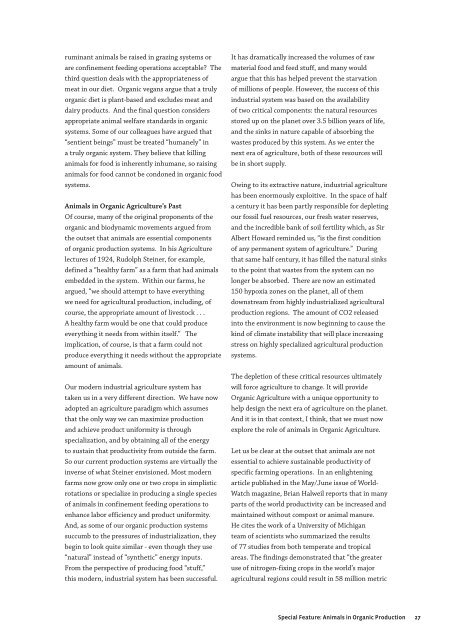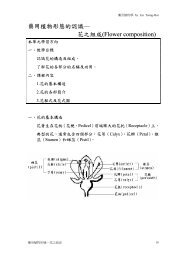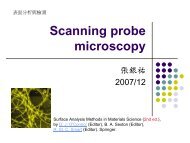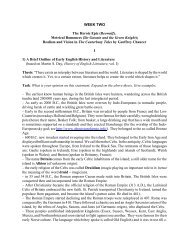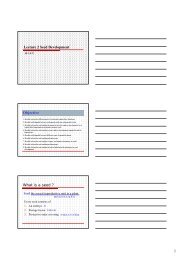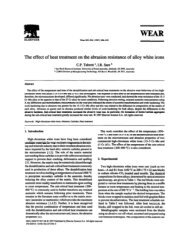Ecology and Farming
Ecology and Farming
Ecology and Farming
Create successful ePaper yourself
Turn your PDF publications into a flip-book with our unique Google optimized e-Paper software.
uminant animals be raised in grazing systems or<br />
are confinement feeding operations acceptable? The<br />
third question deals with the appropriateness of<br />
meat in our diet. Organic vegans argue that a truly<br />
organic diet is plant-based <strong>and</strong> excludes meat <strong>and</strong><br />
dairy products. And the final question considers<br />
appropriate animal welfare st<strong>and</strong>ards in organic<br />
systems. Some of our colleagues have argued that<br />
“sentient beings” must be treated “humanely” in<br />
a truly organic system. They believe that killing<br />
animals for food is inherently inhumane, so raising<br />
animals for food cannot be condoned in organic food<br />
systems.<br />
Animals in Organic Agriculture’s Past<br />
Of course, many of the original proponents of the<br />
organic <strong>and</strong> biodynamic movements argued from<br />
the outset that animals are essential components<br />
of organic production systems. In his Agriculture<br />
lectures of 1924, Rudolph Steiner, for example,<br />
defined a “healthy farm” as a farm that had animals<br />
embedded in the system. Within our farms, he<br />
argued, “we should attempt to have everything<br />
we need for agricultural production, including, of<br />
course, the appropriate amount of livestock . . .<br />
A healthy farm would be one that could produce<br />
everything it needs from within itself.” The<br />
implication, of course, is that a farm could not<br />
produce everything it needs without the appropriate<br />
amount of animals.<br />
Our modern industrial agriculture system has<br />
taken us in a very different direction. We have now<br />
adopted an agriculture paradigm which assumes<br />
that the only way we can maximize production<br />
<strong>and</strong> achieve product uniformity is through<br />
specialization, <strong>and</strong> by obtaining all of the energy<br />
to sustain that productivity from outside the farm.<br />
So our current production systems are virtually the<br />
inverse of what Steiner envisioned. Most modern<br />
farms now grow only one or two crops in simplistic<br />
rotations or specialize in producing a single species<br />
of animals in confinement feeding operations to<br />
enhance labor efficiency <strong>and</strong> product uniformity.<br />
And, as some of our organic production systems<br />
succumb to the pressures of industrialization, they<br />
begin to look quite similar - even though they use<br />
“natural” instead of “synthetic” energy inputs.<br />
From the perspective of producing food “stuff,”<br />
this modern, industrial system has been successful.<br />
It has dramatically increased the volumes of raw<br />
material food <strong>and</strong> feed stuff, <strong>and</strong> many would<br />
argue that this has helped prevent the starvation<br />
of millions of people. However, the success of this<br />
industrial system was based on the availability<br />
of two critical components: the natural resources<br />
stored up on the planet over 3.5 billion years of life,<br />
<strong>and</strong> the sinks in nature capable of absorbing the<br />
wastes produced by this system. As we enter the<br />
next era of agriculture, both of these resources will<br />
be in short supply.<br />
Owing to its extractive nature, industrial agriculture<br />
has been enormously exploitive. In the space of half<br />
a century it has been partly responsible for depleting<br />
our fossil fuel resources, our fresh water reserves,<br />
<strong>and</strong> the incredible bank of soil fertility which, as Sir<br />
Albert Howard reminded us, “is the first condition<br />
of any permanent system of agriculture.” During<br />
that same half century, it has filled the natural sinks<br />
to the point that wastes from the system can no<br />
longer be absorbed. There are now an estimated<br />
150 hypoxia zones on the planet, all of them<br />
downstream from highly industrialized agricultural<br />
production regions. The amount of CO2 released<br />
into the environment is now beginning to cause the<br />
kind of climate instability that will place increasing<br />
stress on highly specialized agricultural production<br />
systems.<br />
The depletion of these critical resources ultimately<br />
will force agriculture to change. It will provide<br />
Organic Agriculture with a unique opportunity to<br />
help design the next era of agriculture on the planet.<br />
And it is in that context, I think, that we must now<br />
explore the role of animals in Organic Agriculture.<br />
Let us be clear at the outset that animals are not<br />
essential to achieve sustainable productivity of<br />
specific farming operations. In an enlightening<br />
article published in the May/June issue of World-<br />
Watch magazine, Brian Halweil reports that in many<br />
parts of the world productivity can be increased <strong>and</strong><br />
maintained without compost or animal manure.<br />
He cites the work of a University of Michigan<br />
team of scientists who summarized the results<br />
of 77 studies from both temperate <strong>and</strong> tropical<br />
areas. The findings demonstrated that “the greater<br />
use of nitrogen-fixing crops in the world’s major<br />
agricultural regions could result in 58 million metric<br />
Special Feature: Animals in Organic Production<br />
2


